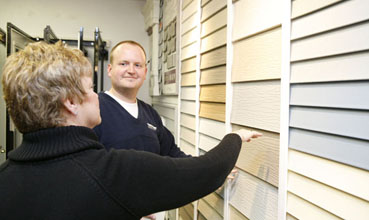Budgeting for my Home Improvement Project
By JR Girskis
Get Free Window Quote
Home improvement projects, if you can afford them, are almost always a good idea as they add value and beauty to your home. Essentially, they improve your quality of life by improving the quality of your home. There are numerous home improvement projects that can add to your quality of life, and if you put in a little sweat equity, you can achieve an even greater return on investment. Here are some ways to figure out if that new home improvement project is right for you, and your family.
Step 1: Determine Your Budget
Step number one always has to be
determining how much you can afford to spend without straining your
current budget. It’s a relatively simple calculation to
make: add your current monthly expenses (groceries, utilities, et.
al.) then subtract that number from your monthly net income (income less
withholding for taxes). The remainder is how much (per month) that
you’ll be able to pay on your home improvement without dipping into
your savings. Of course, there’s nothing inherently wrong with dipping
into your savings so long as it hasn’t been ear-marked for a future
investment like home improvement.
Step 2: Think With Your Wallet
Let your budget guide the
project. If you can’t afford it, you can’t do it, and you’ll just have
to wait for supplemental income or savings to make themselves
available. It’s important to play your home improvement by the
numbers to avoid financial discomfort in the wake of your project. If
the projects is time sensitive, though, there are a few more tips and
tricks
that might put your project in motion.
Step 3: Get a Loan
Finance your project with a personal loan.
Depending on your credit and income, a loan may put you over the top
and allow your project to go forward. Most lenders will
allow you 45% of your debt-to-income ratio. The easiest way to find
out how much they’ll lend you is by just calling or stopping by the
bank to ask.
Step 4: Factor in Equity
Consider
your home improvement options. Some improvements
are guaranteed to increase the resale value of your home while
others will affect it negligibly. If your goal is to increase the
overall value of your home, consider changing the flooring or adding a
bathroom. These
measures will increase resale value dramatically while something
like putting up wallpaper won’t change it much or, if the buyer dislikes
the paper, might actually bring it down.
Step 5: DIY (Do-It-Yourself)
Buy a book. Home Depot offers
free home improvement classes, and you can buy DIY books at large
bookstores (or hardware stores) for usually less than $10.
Compare this to the likely hundreds if not thousands you might spend
hiring somebody to do a particular job for you is going to be the
easiest way to save money right off the line. Stay away from contractors
unless they’re absolutely necessary. With a little elbow grease and
the cost of a how-to book from a major hardware store you can perform
all but the most major renovations yourself.
Step 6: Save the Money
One of the most simple ways to budget
for a home improvement project is to simply save your money. Determine
the cost of the project, when you want it completed,
and then save that amount each month. For example, a $5000 home
improvement project, you want completed in 12 months, will mean you must
save $416 each month. And who knows, by the end of those 12 months,
you may have changed your mind, and now you have a nest egg of
savings for a vacation, or smaller home improvement project.


